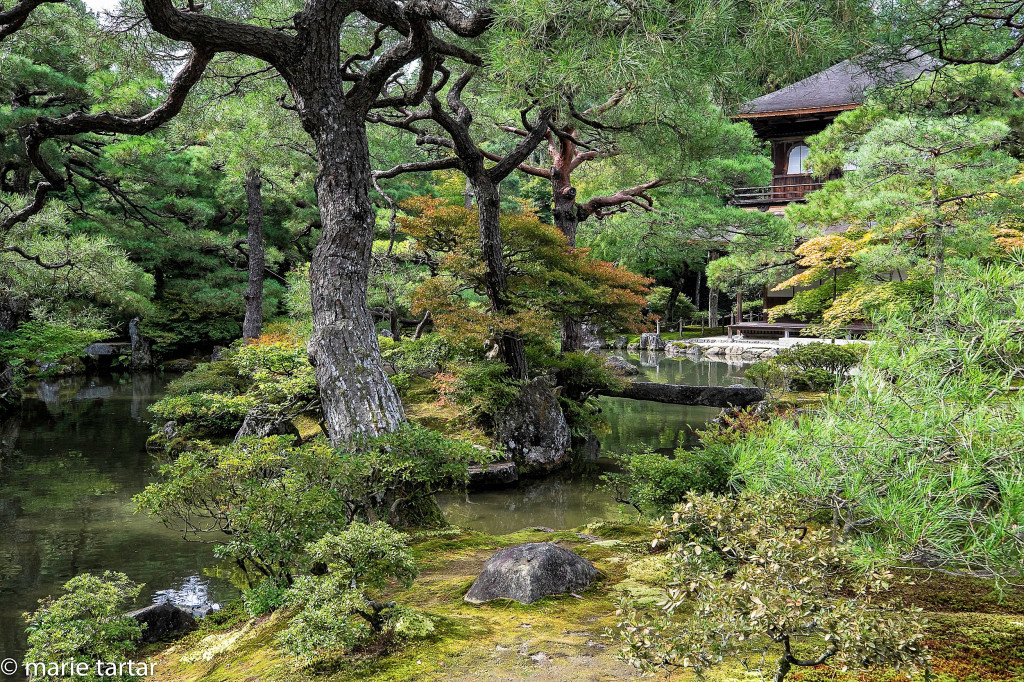
It had been 20 years since we spent any significant time in Kyoto, the historic capital of Japan for over a millenium and a World Heritage Site, also known as the City of Ten Thousand Shrines.
Although we were eager to get reacquainted with at least some of those shrines, we did delay our arrival as late as possible, trying to make the most of a too short stay on Naoshima Island, the subject of Part 1 of this travelog (https://aperturephotoarts.com/japan-redux/). After typhoon Phanfone eroded our planned stay at Naoshima by delaying our arrival, we arranged the latest possible rendezvous, 6 pm, to be met at our Aoi Kyoto Stay apartment. Thanks to the punctual-to-the-minute Japanese trains, we timed it perfectly, arriving at Kyoto Station at 5:30 pm, after catching the 1 pm bus to the ferry, a 20 minute ferry and 3 hours worth of trains from Uno. Philippe showed us through our home for 2 nights, Ayanokoji-bashi, which stylistically struck me as the mid-century designed apartment of Kyoto hipsters, complete with records and a record player.
We always love having the extra space provided by an apartment, and even better if it allows us to experience a vernacular form of architecture. Machiyas are traditional wooden Japanese townhouses, and Kyoto has the best preserved and highest concentration of them. Belated recognition of their architectural significance in recent years has led a few companies to renovate machiyas into visitor lodging, as well as repurpose them into bars and restaurants. The name derives from machi (town) and ya (shop). They typically are tall, narrow and deep, and traditionally housed merchants and artisans, often with a retail space on the street front, and lodging behind. A factor contributing to this shape was that taxes were calculated based on width of the street frontage.
We loved the charming canalside location of our machiya, on a delightfully tree-lined, lantern-lit street, Kiyamachi-dori, filled with innumerable restaurants, with easy subway access to the north on Shijo-dori. It was a small 2 story apartment, well appointed with mid-century furniture. It might not be the best choice for anyone weak of knee, as there were steep concrete stairs to be negotiated between the bedroom and bathroom upstairs, and the mini-kitchen, closet and living room downstairs, but we loved the location, 1 block west of the Kamo-gawa River, right on a canal and a wooden footbridge (from which the name derives).
After expressing a hankering for okinomiyaki, Philippe emailed us a recommendation, which was just a short walk across the river, Kamo-gawa.
The bridges were crowded with people, all agape at the electrifying sight of the moon: a blood moon, actually blood red, WITH an eclipse. It wasn’t until the next night that we realized Kyoto bridges aren’t always that busy. It was an amazing sight, one of the most memorable moons we’ve ever seen.

The Kyoto crowd was out in force, trying to capture the blood moon eclipse. Not having a long enough lens to do the moon justice, we settled for working the moon viewers
Philippe didn’t steer us wrong with his recommendation. Issen Yoshoku, a Gion “institution” per Lonely Planet guidebook, is brightly lit and welcoming, with rioteous decor, including kimono-clad mannequins and comic erotic painted wooden tiles lining the walls, which seemed to be anime Japanese versions of the kama sutra.
The website is entirely in Japanese, but we were steered by the waitress into ordering ours with “everything,” accompanied by Asahi beers. Okinomiyaki means “what you want” and “grilled or cooked” together, but they generally consist of a batter base, made with flour and egg, mixed with cabbage and other ingredients. Issen Yoshoku had a signboard, specifying theirs included “Spring Onion, Beef, Ginger, Dried Shrimp, Tempura Batter, Grilled Fish Paste, Konjak Jelly, and Dried Bonito.” It is comfort food at its finest, cheap and delicious. The first time I had okinomiyaki was years ago, when my uncle took us to a place where you are given the ingredients to cook yourself at a griddle built into the table.
Walking home, we found ourselves on a very atmospheric pedestrian lane, which proved to be a historic geisha district, Ponto-cho. It was lined with restaurants and bars. At one walk-up window, piping hot takoyaki called out to me. Takoyaki (tako-octopus; yaki-grilled or cooked) are another local speciality, a round ball of batter containing octopus bits, tempura scraps, pickled ginger, and green onion, poured into a special cast-iron pan with round molds and turned while cooking, until the exterior is crispy and golden.
Thursday, October 9, 2014
We spent the day out with Naomi Sakamoto, a professional guide from Osaka, whose guidance Ralph and Gail had enjoyed on their recent trip.

Our guide Naomi waits patiently as we stop every 10 feet for another picture, Inari Fushimi Shinto shrine
Our first stop was Kyoto Station, where Naomi negotiated unsuccessfully on our behalf to have a “typhoon” day added to our week’s JR rail pass. From there, our first excursion was south, towards Nara, to visit the Fushimi-Inari-taisha shrine, a gorgeous sight, with the brilliant orange staggered, tapering in size Shinto shrine torii gates forming a gorgeous procession up into a verdant green forest. Steve pointed out that Christo and Jean-Claude must have had this site in mind with “The Gates” project in Central Park.
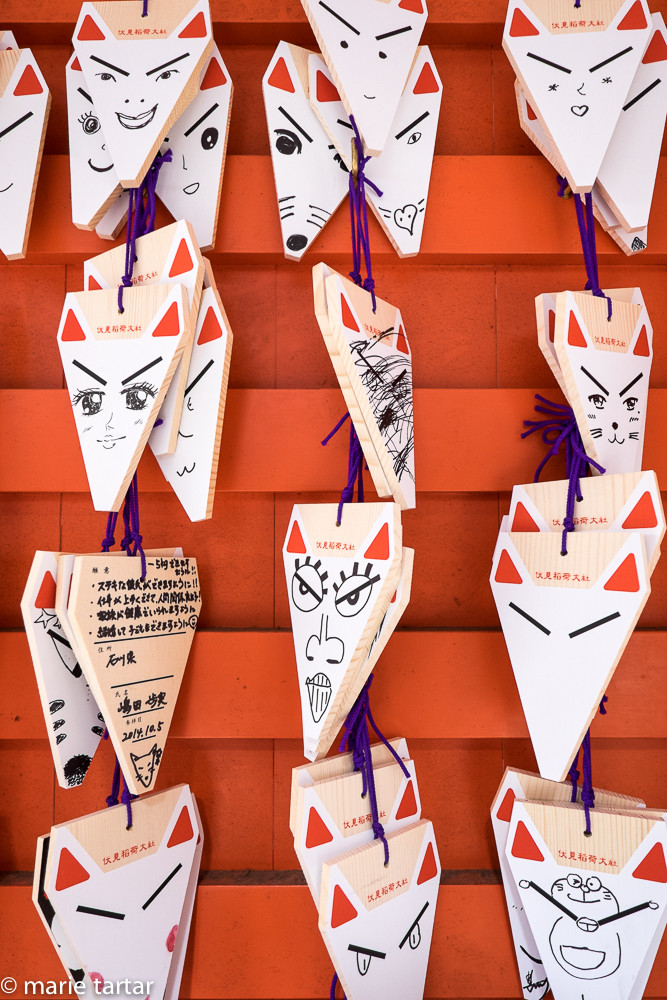
Visitors to a Shinto shrine may be motivated by a romance or an upcoming exam enough to immortalize their wish with artwork like this
After a quick bite in Kyoto Station, onigiri and a chestnut pastry, it was off north on a crowd avoidance choice of quiet gardens in the huge Daitoku-ji Zen temple complex. There are 24 sub-temples, including Koto-In on the far western side, where we had a tea ceremony on the veranda facing a moss lawn fronting red-turning maples backed by a bamboo forest.
Our last major stop was Kiyomizu-dera, where there was no avoiding the crowds of international and Japanese tourists, other than on the approach. The final leg in the taxi was so held up by buses trying to disgorge their passenger payloads that we bailed on it, joining the throngs of school kids in yellow caps heading there. Standing on the crowded street corner waiting to cross, I saw a lovely looking, empty appearing alternative route, across a stone bridge and suggested we try that. It was through a masoleum, and a peaceful alternative to the sardine migration heading up the usual way. On the way home, heading downhill from Kiyomizu-dera, the streets were slick with moisture, just enough that the schoolkids were taking advantage, running and sliding down the street, shrieking with delight.
Our dinner destination, Sumire, was an elegant Chinese bistro, a 30 second walk from the apartment. This recommendation came from a guidebook on Kyoto machiya by Judith Clancy, and was a fulfillment of my promise to Steve that we wouldn’t have Japanese food every night. Asian food maybe, but not Japanese. On our first trip to Japan in the early 1990s, he was so burned out on Japanese food after 2 weeks that it took years for him to recover any real interest in it. The only part of the menu we could read was the wine list, so we ordered a bottle of Argentinian Torrontes to share. After that, I took a deep breath and ordered omakase o kudasai, and hoped for the best. A series of small plates followed, a “salad” of thinly sliced chicken with a peanut sauce, accompanied by broccoli and cauliflower with a vinaigrette marinade, mini dimsum in a bamboo steamer, roasted pork and shrimp in a ginger orange sauce, all delicious and just the right amount of food.
Friday, October 10 started with a hunt for our next accommodation, an apartment which proved to be practically next door. I hadn’t set out to have to move during our stay in Kyoto. I’d planned to hopscotch from Tokyo, to Kyoto for a few days, then to Naoshima Island, then back to Kyoto, which is why I only booked 2 days at our Aoi Kyoto Stay apartment. By the time I figured out that additional days were not going to open up at Naoshima and that we’d have to go immediately, most of central Kyoto was booked solid.
I knew our next accommodation was close, but it was surprisingly difficult to actually find the name of the street on a map. Finally, we gave up and we headed down the street, looking for any clue. It was 2 bridges away, on the same canal, about 1 minute walk.
After successfully transferring our luggage, we were off to explore Nishiki Market a few blocks north. We loved this covered historic market so much, it became a near daily part of our circuit.

“Irrashaimase!” : Greeter at Nishiki market welcomes customers and offers samples of pickled vegetables
It is filled with food vendors of every type, restaurants, fish mongers, pickle barrels, produce, sake stores, everything consumable.
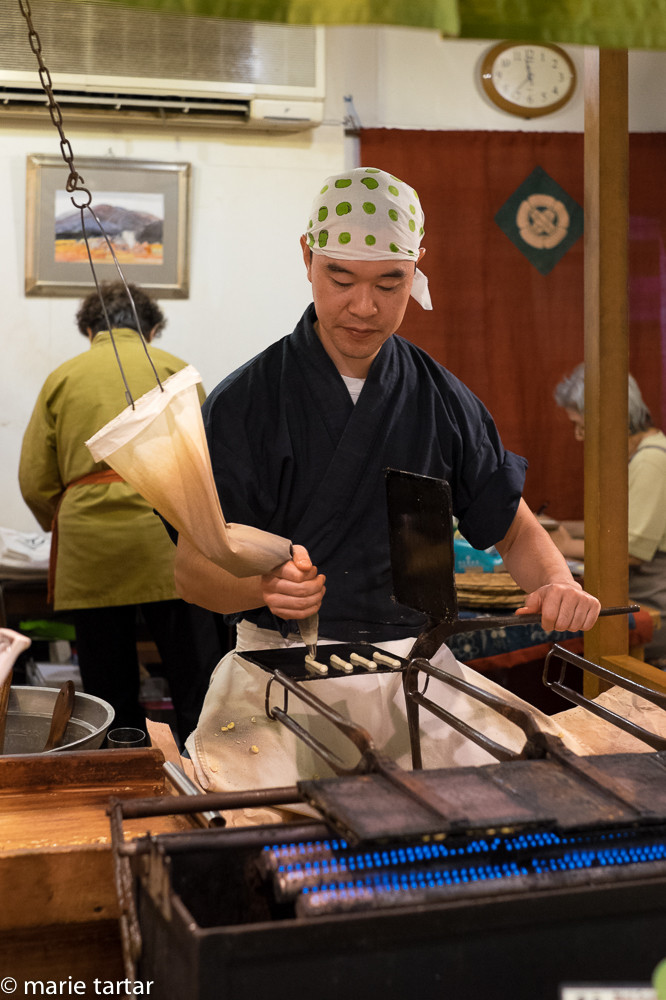
How sembei (rice crackers) are made, on a griddle; the freshly made ones from this source in Nishiki Market were oishii!
After sampling a delicious salad of grilled shishito peppers from one shop and a savory rice mixture from another, it was time to get serious about lunch. Just a block from the west end of Nishiki Market was Warui, another okinomiyaki joint. This one has griddles at the table, but they do the assembly and pop it onto your piping hot griddle. You just have to dress it as you like it, then serve yourself with a little metal slicing spatula. Oishii!!
We spent an idyllic afternoon on the west side of town, including the Arashiyama bamboo forest, Tenryu-ji Temple and garden, and finally the gorgeous grounds of the former home of a Japanese silent screen star, Okochi Sanso.

Gorgeous couple having their wedding photos taken in a gorgeous setting, Arashiyama bamboo forest in western Kyoto
For dinner, Naomi had reserved her favorite kaiseki restaurant in Gion, Gion Rakuraku.
It was a small place with massive wooden bar, with but 10 seats, occupied by us, a Japanese couple and a couple from Paris on their first trip to Japan, Jérôme and Sandrine. He is a designer (his first job was designing scuba equipment) in Japan for an award’s ceremony.
After a delicious meal, accompanied by Naomi’s favorite sake, peach drop, the owner, Satoshi Nakata, appeared and showed us magazine articles attesting to his status as an expert on tea ceremony. He collects objects d’art connected with the tea ceremony, and showed us 2 Thai celandon serving bowls collected from a cache at the bottom of the sea for hundreds of years.
Saturday, October 11, 2014 was organized around the search of ceramics.
We spent a restful first night at Bijuu. The apartment is huge, with a small kitchen and tiny terrace. The building overlooks the same canal as Aoi. We learned on checking in that this room was completed 3 days before. The apartment is so fresh we suspect we are the first to stay there. There are a few kinks to be worked out, but they respond well after we notified the management (who brought our Japanese breakfast in the morning) of the need for more hangers and the more urgent need to dim the exit sign (handled the night before with eyemasks). It is attractively outfitted with mid-century modern style furniture, even Serge Mouille lamps. There are only 2 rooms in this hotel, with other floors occupied by another apartment on the 5th floor, the management on the 4th, us on the 3rd, a restaurant “Kiln” on the 2cd, a cafe on the 1st and a gallery in the basement.
Breakfast was initially offered between 9 and noon, which wouldn’t work for us to see our friend Gordon’s dealer in contemporary Japanese ceramics, Robert Yellin, at 10:30 or so, in advance of a group he was expecting for brunch. Arrangements were made for breakfast at 8 am. The gallery was reportedly very close to Ginkakuji (The Silver Pavilion) in northeast Kyoto, and per Naomi, very difficult to find, on a very small street. The street name Ginkakuji-no-mae sounded like “in front of Ginkakuji” to me, so that didn’t seem too intimidating. Having seen numerous buses on busy Shijo-dori that said “Ginkakuji via Gion”, we decided to test the reportedly comprehensive bus system out. The hardest part was having the correct change at the ready (230 Yen), but there are machines up front to change 1000 Yen notes. The other potential difficulty is maneuvering up front to disembark and pay if the bus is crowded, after entering from the rear. But we had no problem, and soon found ourselves at the temple, another one of Kyoto’s 17 World Heritage Sites. Our timing was good, still early enough that the peace of the beautiful grounds wasn’t overwhelmed by the busloads of tourists we encountered entering as we left.
One of the waiting rickshaw drivers pointed the way to the street, and thankfully, Steve found the discrete sign just before we mounted a serious set of stairs at the end of the small, dead-end street. Robert has lived in Japan for decades, but is a San Diego homeboy, a Torrey Pines High School grad. His house and gallery are in a traditional Japanese house, with sliding panel doors looking out to the garden. Our interest in visiting him was peaked by Gordon’s superb collection of contemporary Japanese ceramics, the subject of one of our favorite Mingei Museum shows of recent years. It was a treasure trove. Thankfully, we had Steve’s recent birthday, as well as Christmas and Hanukkah as excuses to invoke as we eyed the seductive objects d’art. We settled on 3 pieces, to be shipped in the coming weeks, wonderful remembrances of our sojourn in Kyoto.
As we left, Robert echoed the many recommendations we had received for Omen (honorable noodle), but gave us an a invaluable back-up plan: if Omen was mobbed, try Nashimote, next door to Gospel, a coffee shop in a white Victorian, for grilled meats and seafood. Omen was indeed jammed, and we already had reservations at their downtown branch, a few steps from our apartment, so that was easy. Except that the tiny restaurant had only one seat open around its U shaped bar, centered on the open grill.
Not to worry, we headed a street over to the Philosopher’s Path, shaded, quiet and verdant, for a half hour. The owner’s limited but willing English got us over the hurdle of the undecipherable Kanji menu.
Our meander south along the Philosopher’s Path was protracted enough, including Honen-in, that we decided to postpone a planned visit to the Kawai Kanjiro home and studio for another day. The bus took us most of the way home, at least as far as Gion. By now, our cash reserves were low enough that stocking the apartment with a sake we had sampled in Nishiki Market was problematic, so to 7-11 we headed-yes, oh thank heaven, they are near ubiquitous and accept foreign cards in their ATMs. (They really are a welcome sight in Japan; it can be difficult to find ATMs which accept foreign bank cards otherwise (Citibank is another less ubiquitous option). I also remember a sweltering day in Thailand years ago in which we reveled in the delightfully crisp air conditioning of a 7-11 in Phuket. Two reasons to love 7-11 in Asia!).
Back in the neighborhood before the market closed, with aching feet, I suddenly remembered a young woman who had given us a flyer for a massage parlor, pointing up to the 3rd floor, near one of the entrances to Nishiki. The flyer showed dumpy women transformed into models of posture and slenderness by (presumably) acupuncture and other offerings of the clinic. I was in search of relief for aching feet. They were able to take me immediately. I elected the “body and foot” combination, about $70 for an hour. This was not the oasis of quiet and calm we associate with spas in the US. Only curtain partitions separated client and therapist pairs. Somewhere in the room, a male client and his female therapist chatted animatedly the entire hour. I was given an oversized T shirt and stretch track pants to don. While I wasn’t transformed into a willowy waif like on the flyer, it was a terrific massage and experience.
Dinner at the downtown Omen was just a few steps from our door, and with a reservation, we were whisked upstairs past a hungry looking throng in the foyer . I elected the hot udon and noodle option, with Kyoto vegetables and tempura, while Steve selected the cold option. We tentatively dipped our noodles at first, then gained confidence, shaking pepper and spices onto the broth, ladling on the shredded radish, finely diced scallions, and other crispy additions with gusto as we progressed.
Sunday, October 12, 2014
A very full day, starting with a walk south and across the river to Kawai Kanjiro’s house and studio. I had read about it on Robert Yellin’s website and chatting with Robert the day before reinforced our resolve to make it there this visit. He was a potter and wood sculptor, a contemporary of Soetsu Yanagi and was very involved with the mingei movement from the beginning. He built his home, which is a beautiful example of traditional Japanese residential architecture, and it is filled with objects d’art, including unique furniture of his own creation.
The afternoon was devoted to the Miho Museum, an excursion west of Kyoto, first by JR train to Ishiyama, then a scenic 50 minute bus ride on bus number 150.
Designed by I.M. Pei, the museum was finished in 1997. It is named for a religious leader whose organization and family founded the museum, Mihoko Koyama. Her personal collection of antiquities from Japan and elsewhere in the ancient world, form the collection. This is another spectacular union of site and clean contemporary architecture.
After walking home from the station, we were happy to dine nearby, one floor down, at Kiln.
Especially after a very full day and an unfortunate incident of toilet malfunction. Japan is known for having the most advanced toilet technology in the world. The squat toilet is becoming an increasingly rare sighting (although we did see a few, at the smaller and yet smaller stations en route to Naoshima). Toto toilets are now near ubiquitous, and have an astounding range of options, from the seat lifting as you approach, muffling rushing water sounds as you seat yourself, the seat itself heated, and a variety of directed cleansing water jets which can be customized. How can this marvel of technology malfunction? Suffice to say that the directed water jets require the aperture of the toilet to be sealed by one’s derriere for optimal function. I found out the hard way (wet hair and running mascara) just how high the (clean) water can be directed, if unchecked by a tush in need of cleaning. Steve claims it was an accident…
What was waiting for us downstairs was a comfortable setting, with Japanese hipsters around large wood communal tables, a mixologist working his trade at one edge of our table, and a large open brick-lined kitchen.
We shared fig and goat cheese salad, and two different duck preparations. Mine was the winner, duck confit with pomegranates, pumpkin seeds.
Monday, October 13, 2014: Our last full day in Kyoto, with typhoon #2 en route. While lingering over breakfast, I found the surprisingly chic looking Piece Hostel Kyoto near Kyoto Station, and decided to stay in Kyoto rather than head to Nagoya on Steve’s departure. We headed to Takashimaya on Shijo-dori, where Steve hung out outside, street shooting, while I tried on some oh-so-packable Issey Miyake pieces inside. Chatting with the salesgirl, and later, with the woman processing my tax refund, it became clearer that train service would be suspended later that day when the typhoon became more full blown. Already it was raining steadily, and intermittently gusting. After lunch at Warui for sauceless okinomiyaki (better without mayo), we headed for Sanjo-dori and any bus marked “Kinkakuji.”
Kinkakuji is among the most spectacular of the Zen Buddhist temples, and even under the building rain and wind of the approaching typhoon, lived up to memory and reputation. The pond and grounds represent the Pure Land of Buddha in this world, and it is indeed a world of visual perfection.
There were still a respectable number of other tourists to share it with, but not unmanageable.
A sizable number were sheathed in plastic bags of various colors, and umbrellas made it a little more difficult to shoot but still workable.
The approaching typhoon emptied the streets as evening approached. While in Takashimaya, the possibility of the store closing earlier than the normal 8 pm closure was mentioned. When we emerged from the apartment for the quick trip to Omen, it was dark, with a sign on the door: Closed at 4 pm due to the typhoon. Heading back along Kiyamachi-dori, we saw that Scorpione was open. It was virtually empty. We were given a riverside view table upstairs, the only other occupants being a boisterous group which grew from one women and 2 men, to one woman and 5 men, sharing beers with the waiter, by the time we left. This was one of the listings in the “restaurants in machiya” book, although it was listed in Gion in the book. It was a beautiful traditional building, with a lovely river view. This night, it was punctuated by rain coming down in linear streaks, as depicted in Japanese woodblock prints. The river was clearly higher in level and running faster than before as well. Steve had a scrumptious kale salad to start (it looked like a giant brussel sprout) which I liked so much I was tempted to order another, but my “small turnips” soup was a bit bland (or brand, as Steve imitates my mother when he wants to annoy me). I did like my pasta, with roe and miniature whitefish, a local spin on Italian food.
Tuesday, October 14: Swapping Steve for Mama, and a little time to myself.
Thankfully, typhoon #2 came and went without ramifications for us. The next day dawned washed and sunny, as if torrents of rain had never happened. My transfer to Piece Hostel near the station and plan to see Steve off at the station were nearly foiled by the cab driver, who circled around and around, searching for the hotel. It WAS a little concealed, but with our extra time evaporating and doubling of our cab fare, it was a little annoying. It was a quick walk to the station. After securing a shinkansen ticket for Steve and seeing him to the right section of the station, Steve was en route home to spend the rest of the week in Sedona, while I had 2 days and a night to myself for a solo adventure before meeting up with Mama to visit the family, the subject of an eventual Part 3 of this series.
-Marie

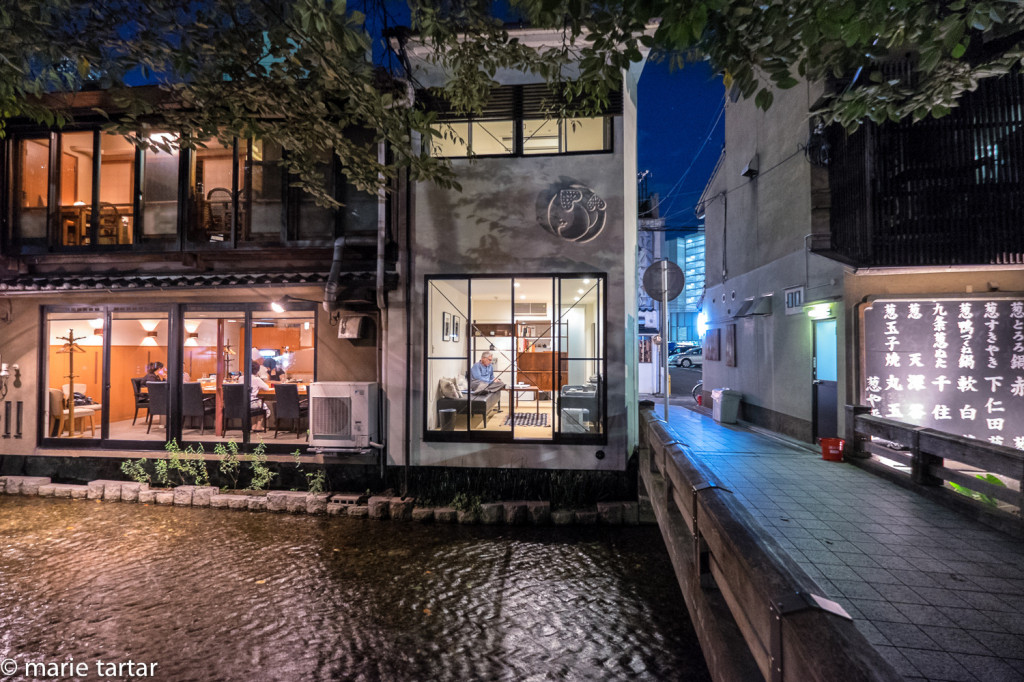

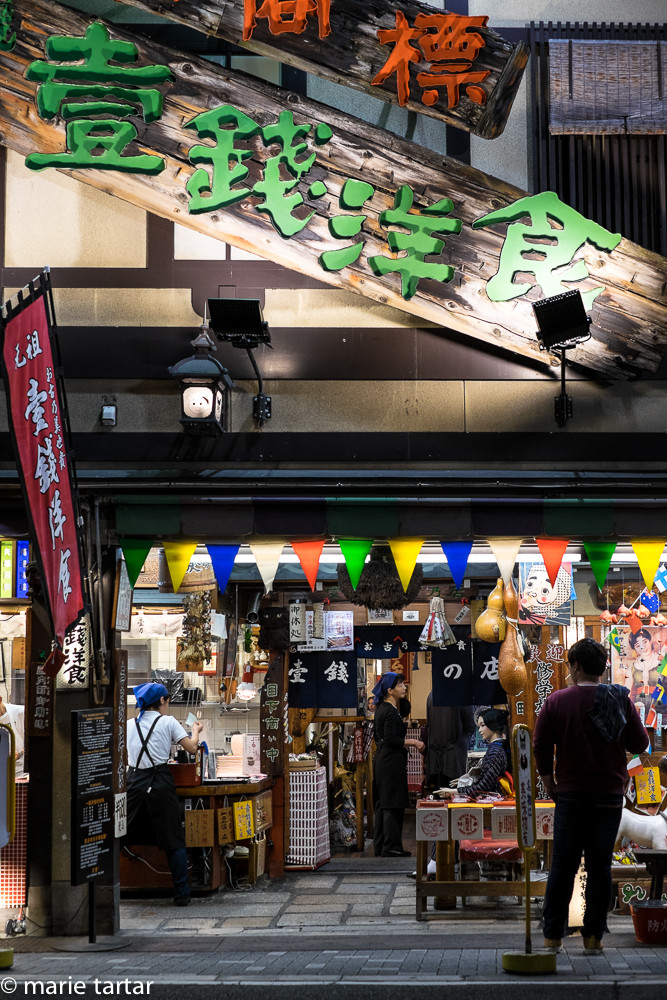
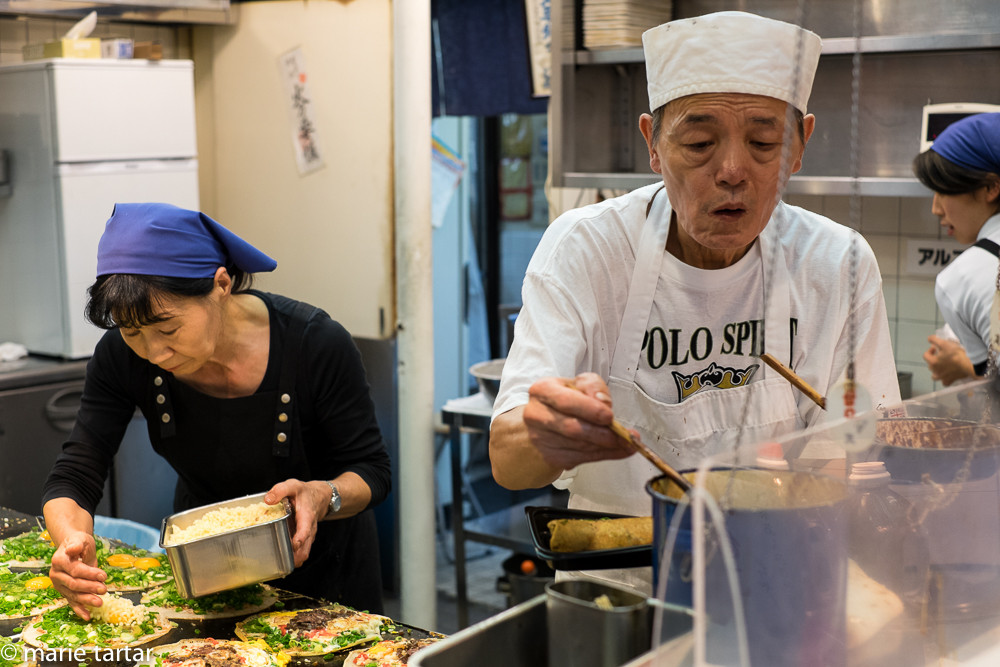


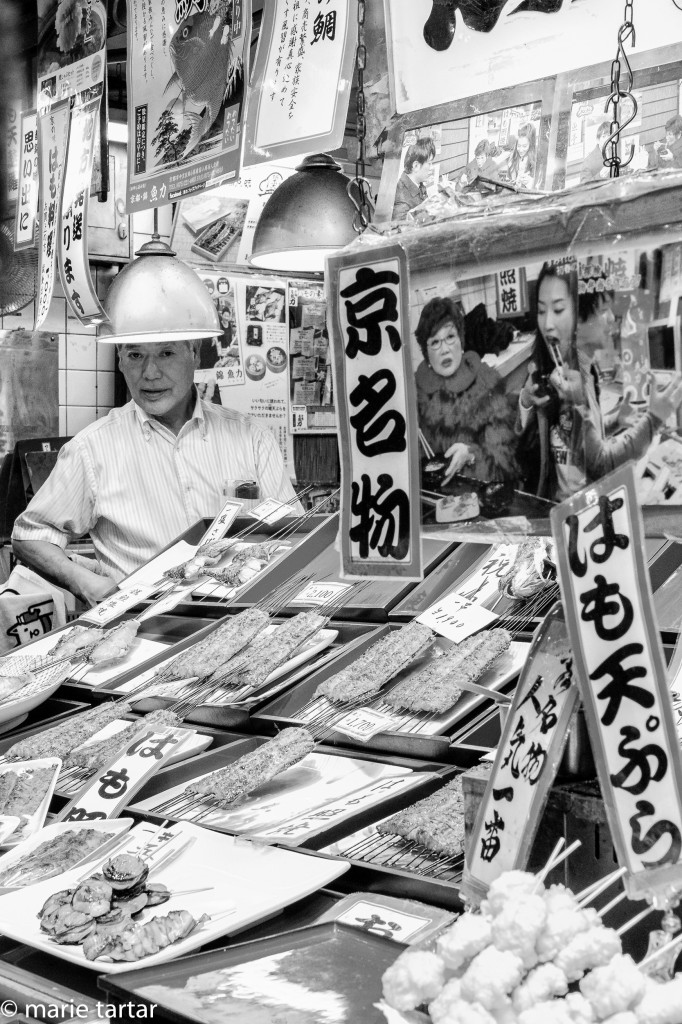
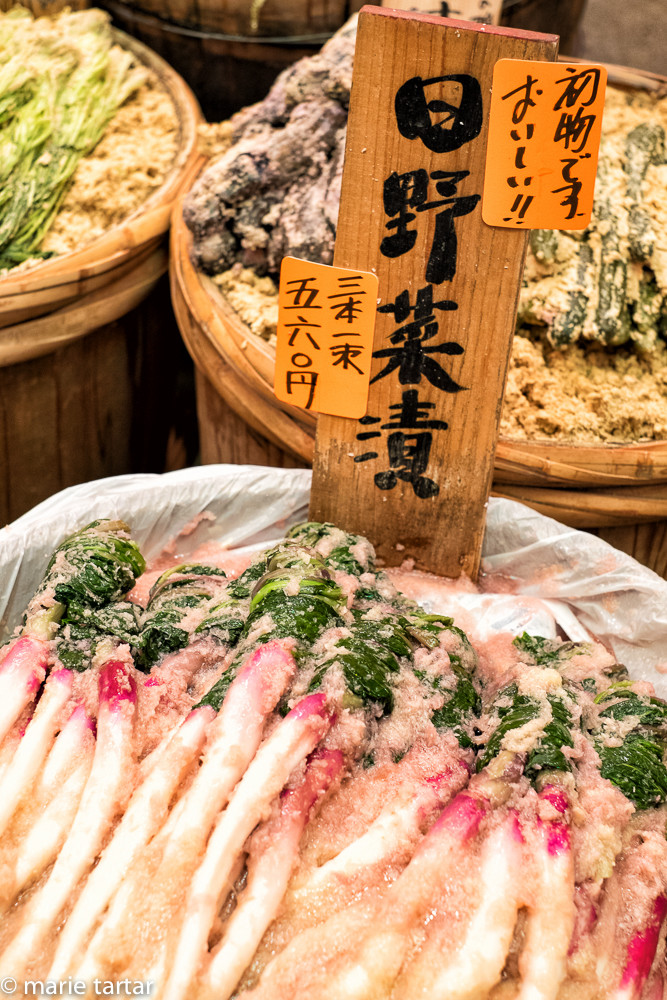
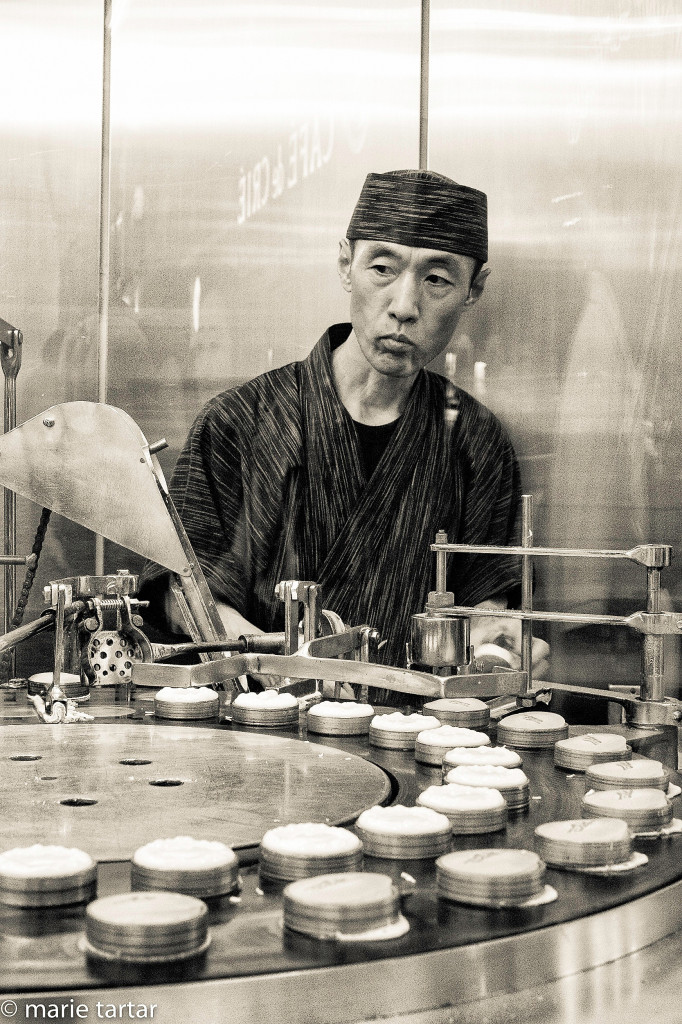
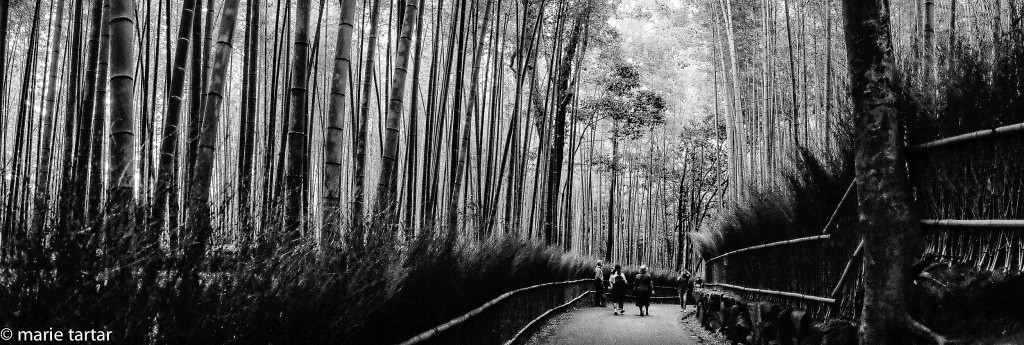
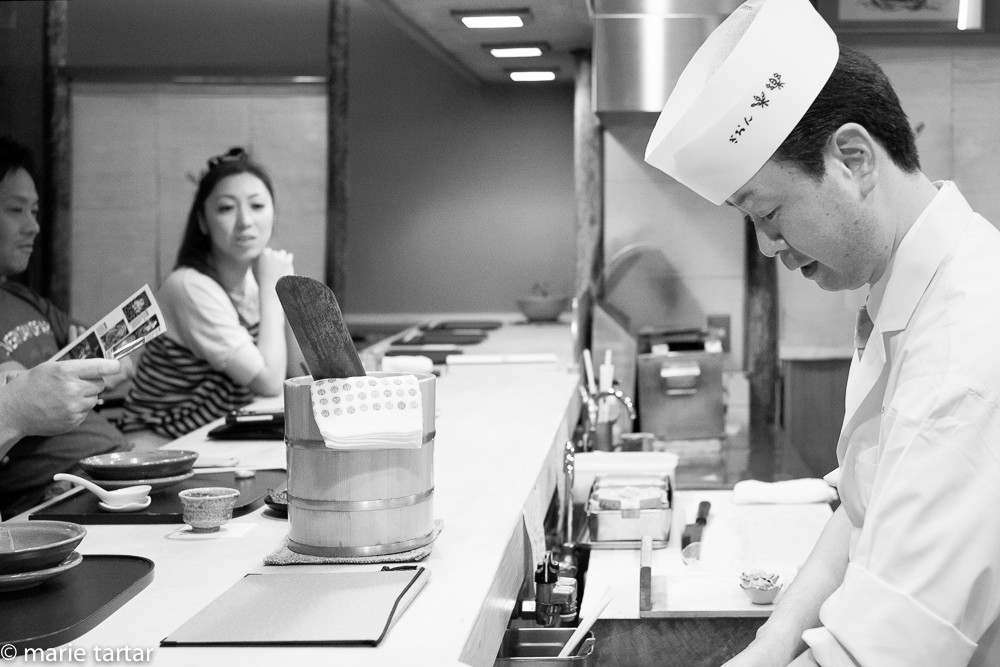


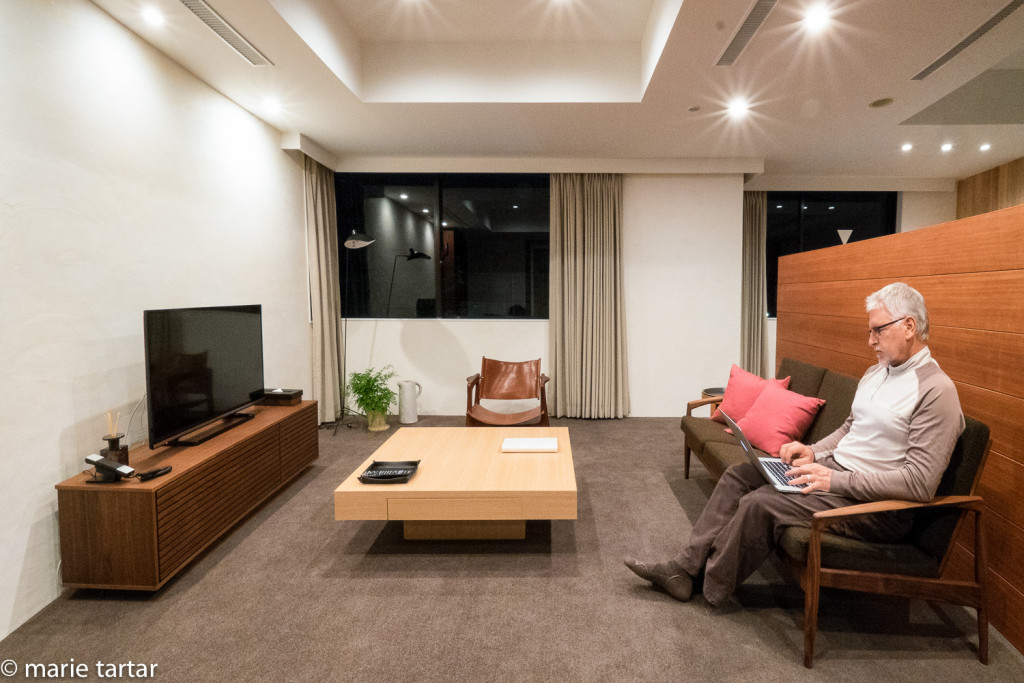
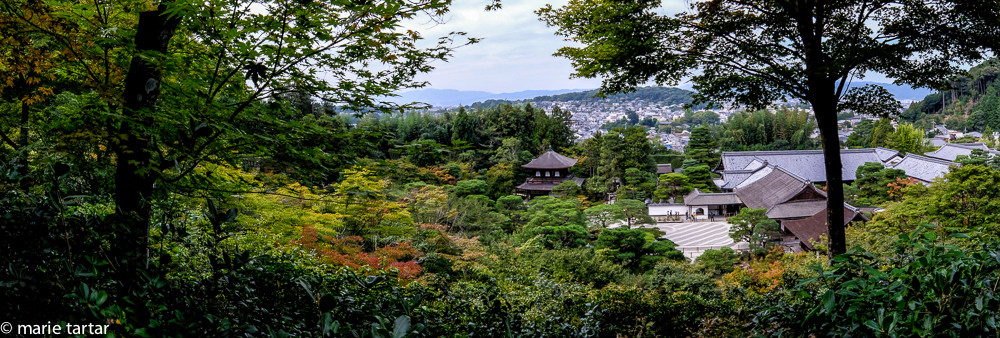
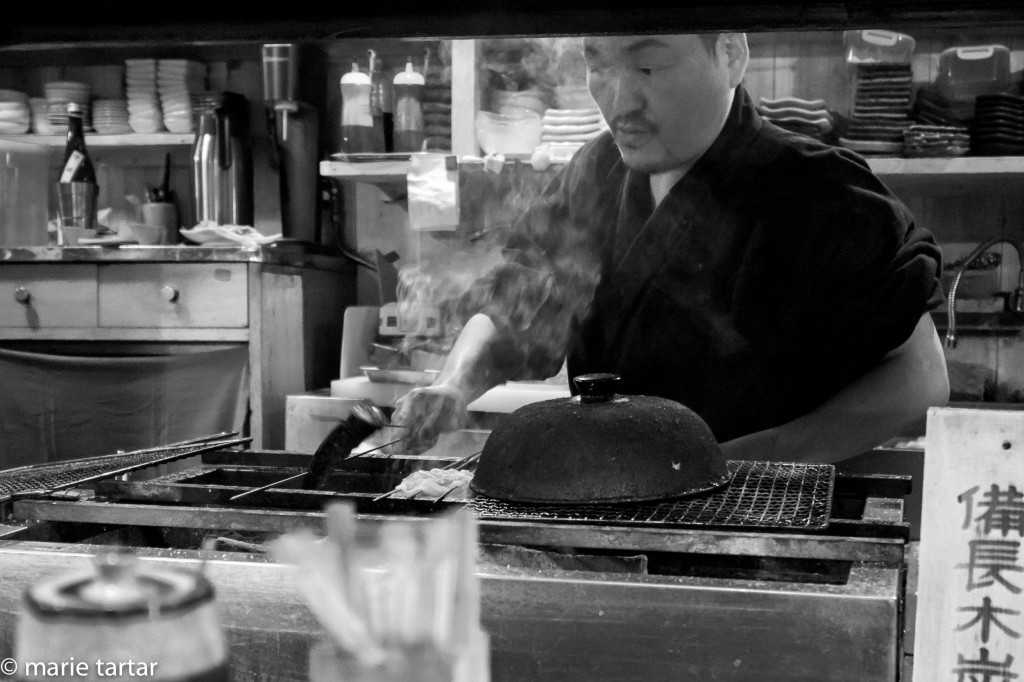


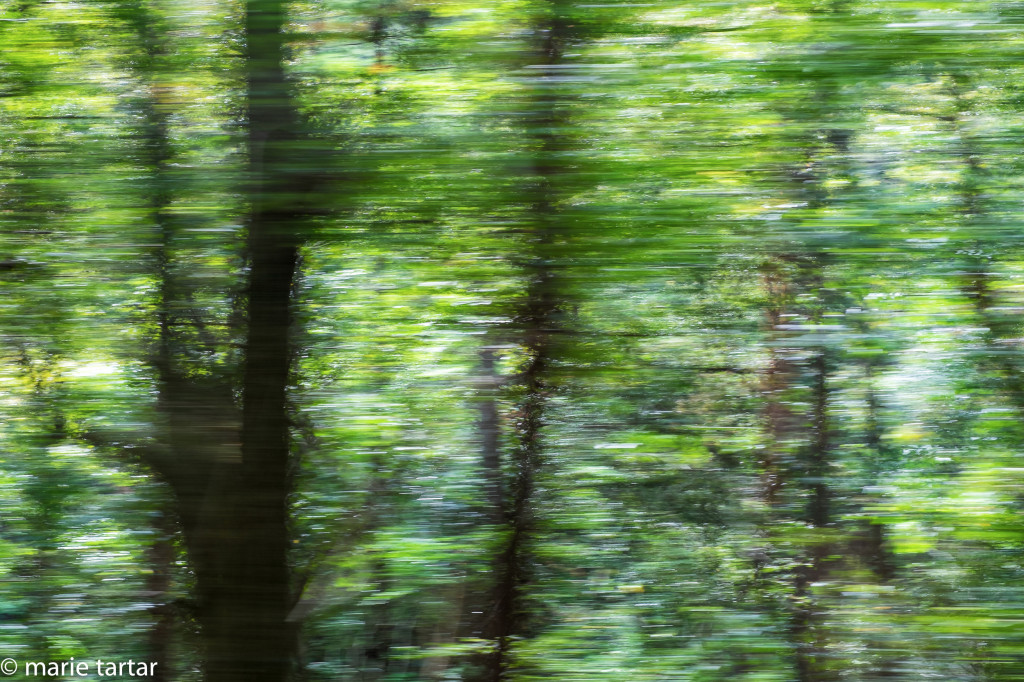
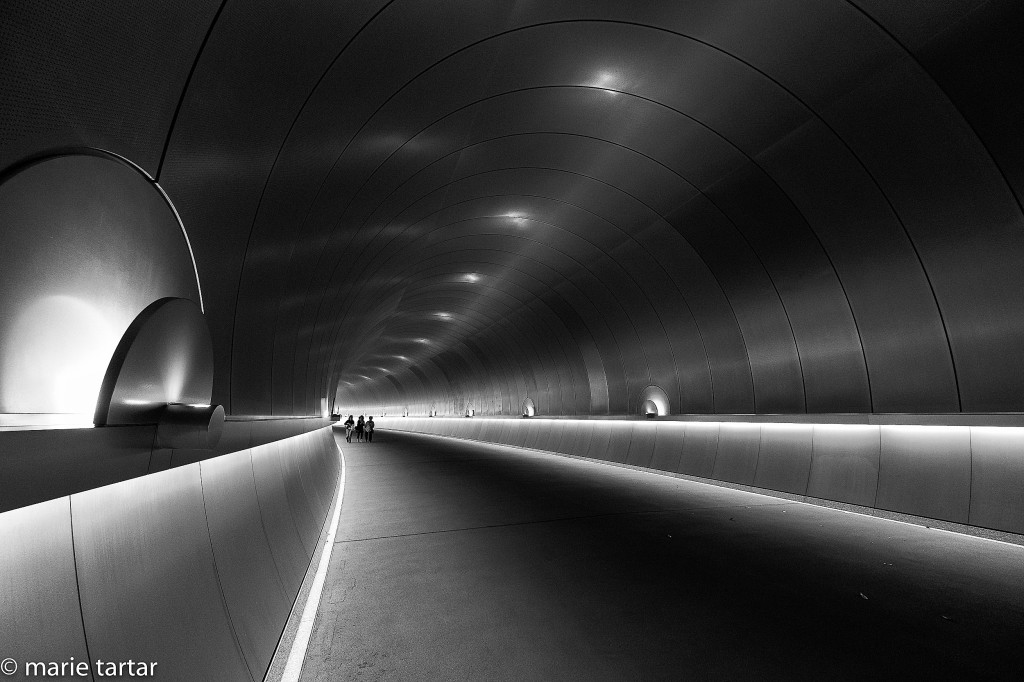
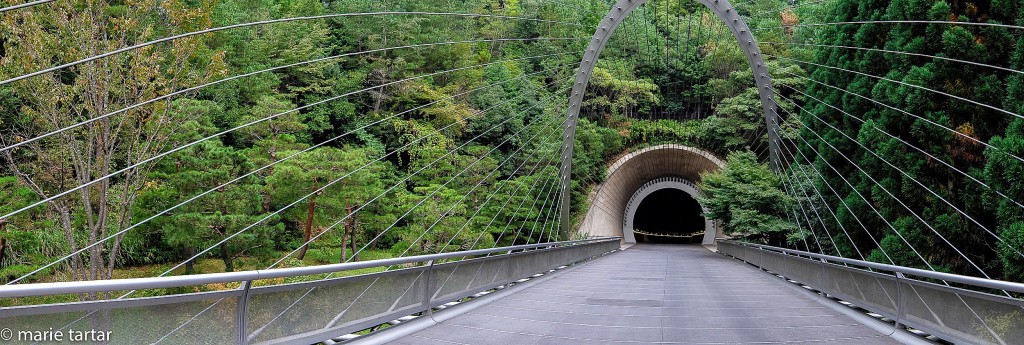
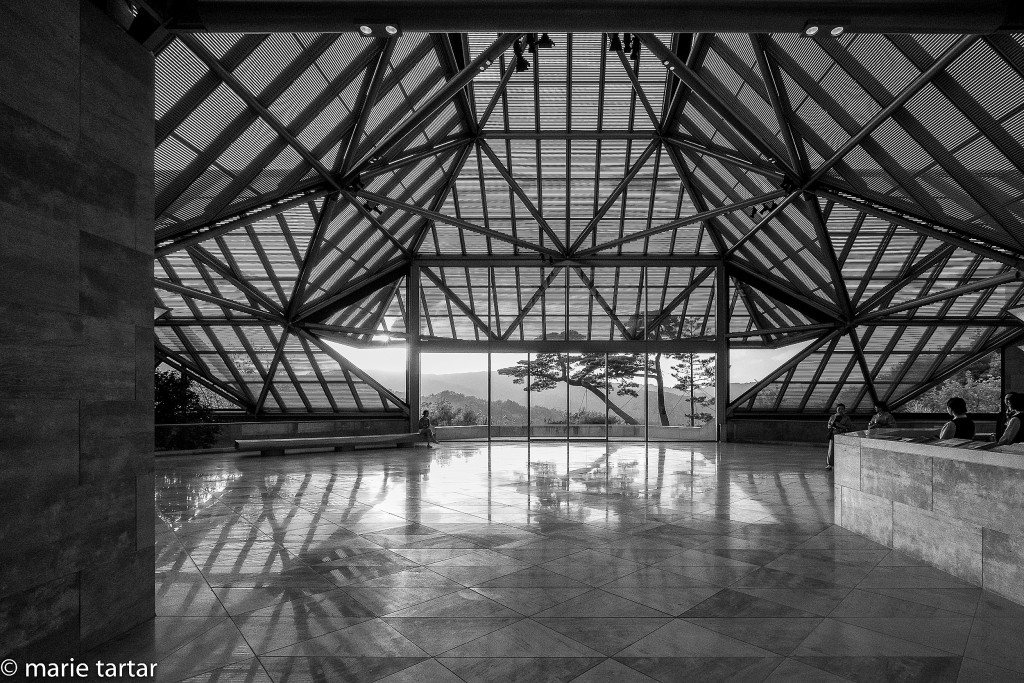
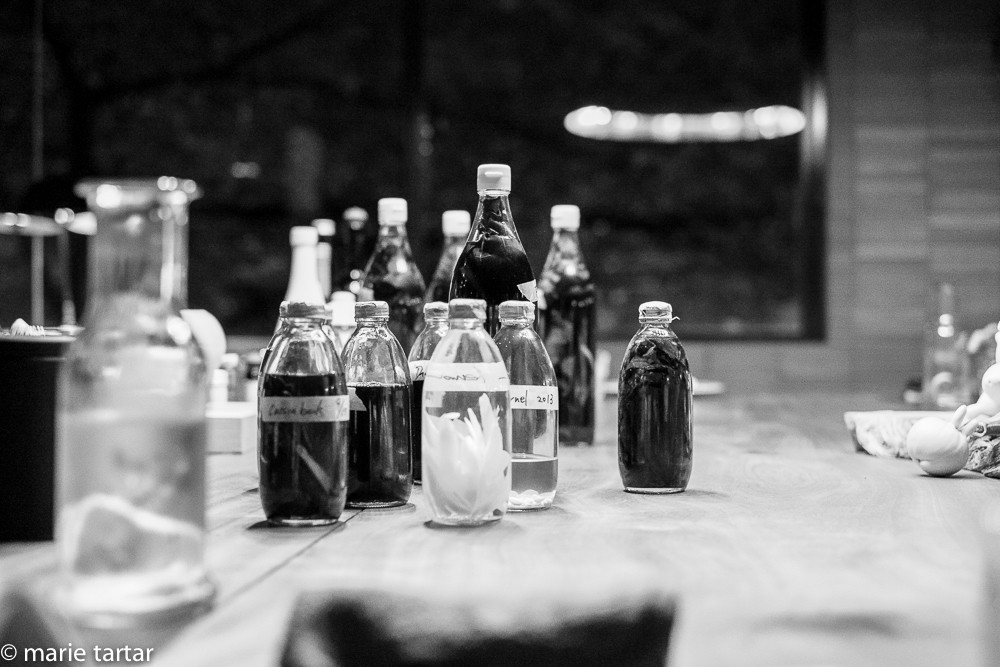
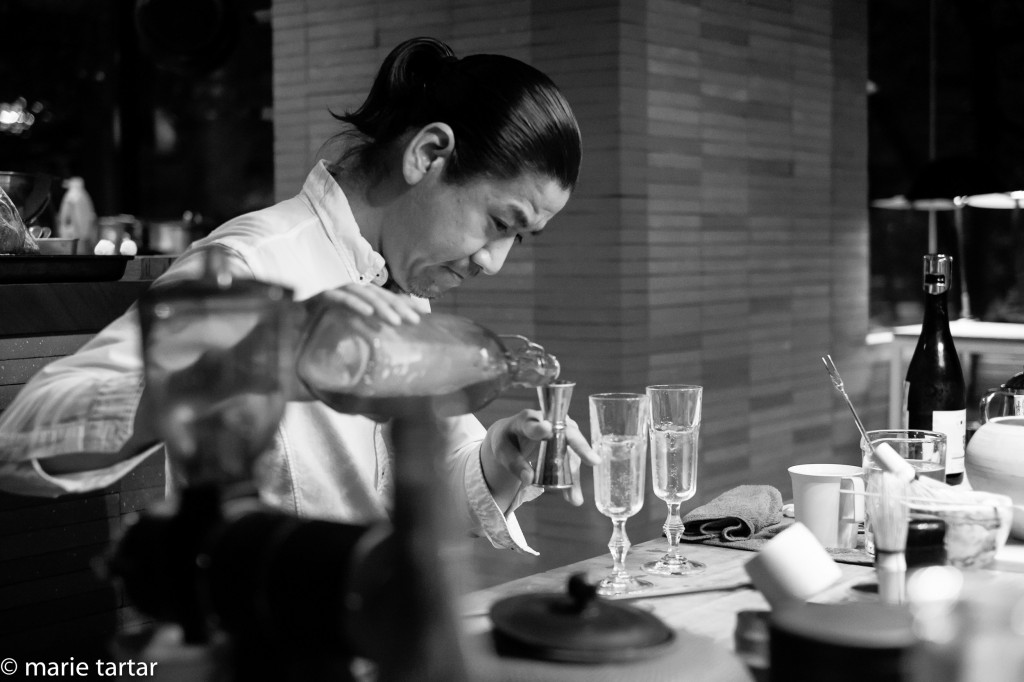
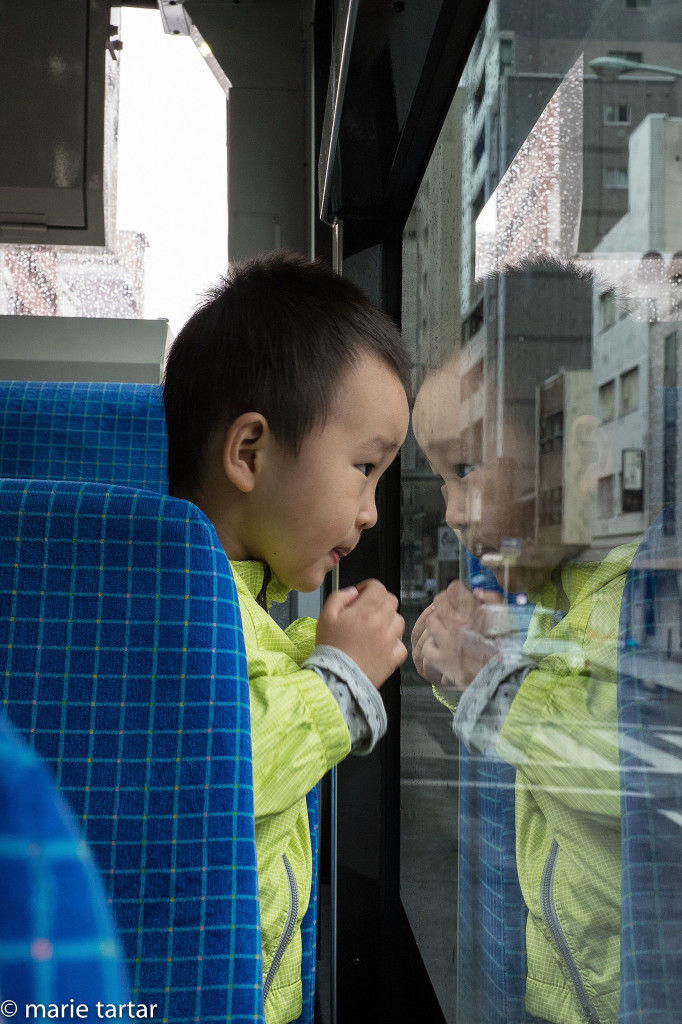
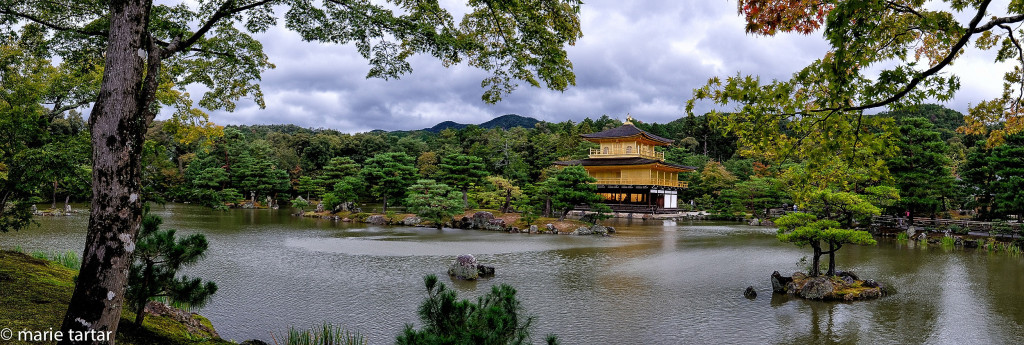
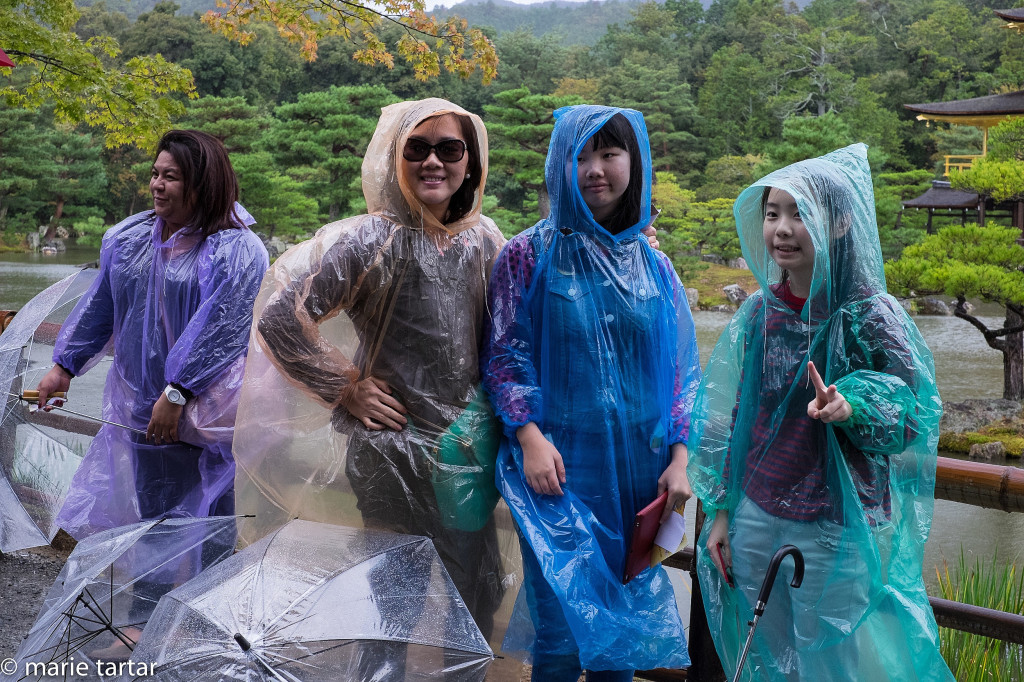
I didn’t realize that I had a trip to Japan in my horizon until I read your blog:) And now I am sooooo hungry for Japanese food. Great read. Wonderful photos!!
Marie san,
You really should consider becoming a photographer or travel counselor:) Just got back from trip to Japan in June and your photos and commentary make me want to go back again. Thank you for sharing your photos and you and your husbands adventures.
Hi! May i know the name of the place of the Machiya you stayed?
Thank you!
Hi, We have stayed in 3 different machiyas, all through Aoi Kyoto Stay, including Ayanokoji-bashi, Takasegawa, and Manjuji-bashi. All were delightful & wonderfully located along the same cherry tree lined canal. Highly recommended!